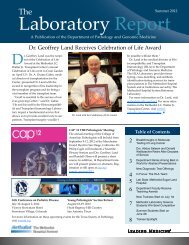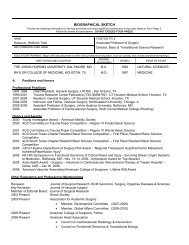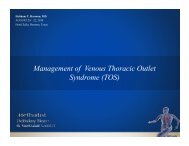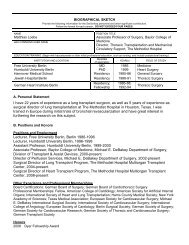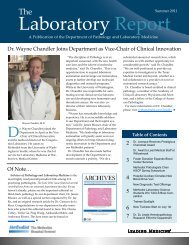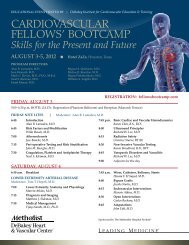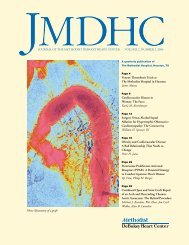DeBAKEy CARDIOvASCuLAR JOuRNAL - Methodist Hospital
DeBAKEy CARDIOvASCuLAR JOuRNAL - Methodist Hospital
DeBAKEy CARDIOvASCuLAR JOuRNAL - Methodist Hospital
Create successful ePaper yourself
Turn your PDF publications into a flip-book with our unique Google optimized e-Paper software.
Vascular Access Complications<br />
A number of local vascular complications have been<br />
described and are observed in 0.5 to 1.5% of patients,<br />
although these complications are probably underreported.<br />
They occur after left heart catheterization and<br />
arterial access.<br />
Perforation of peripheral arteries by a guide wire or<br />
a catheter is uncommon but may occur in cases of very<br />
tortuous vessels and when stiff wires and catheters are<br />
used. A retroperitoneal hemorrhage can occur with or<br />
without hemodynamic compromise. The use of a J-type<br />
tip prevents this rare complication.<br />
Artery dissection is more frequent with stiff guide<br />
wires, but fortunately the flap is created against the<br />
flow of blood (from distal to proximal), and in most the<br />
cases the flap is sealed. However, dissection may promote<br />
local thrombosis and artery occlusion.<br />
Arterial occlusion is rare. It can be observed when<br />
the femoral artery puncture is done exactly at the site of<br />
an atherosclerotic plaque. This “iatrogenic” plaque rupture<br />
may lead to thrombosis in situ and occurrence of<br />
acute leg ischemia. In most cases, this peripheral acute<br />
leg ischemia is related to a distal embolism of a plaque<br />
or a fragment of plaque dislodged during the passage of<br />
the catheter in an atherosclerotic iliac artery. This complication<br />
requires rapid embolectomy with the Fogarty’s<br />
catheter.<br />
Pseudoaneurysm is an intraparietal artery hematoma<br />
14 characterized by swelling at the puncture site<br />
and a murmur at auscultation. Initially, surgical repair<br />
was recommended, but ultrasound-guided compression<br />
therapy (uGCT) is currently the nonsurgical recommended<br />
treatment. 15 Routine color duplex control of<br />
the puncture site the day following the removal of the<br />
sheath after percutaneous catheterization and uGCT<br />
increases the success rate of uGCT and minimizes the<br />
need for surgical repair. 14 Infection may occur at the site<br />
of pseudoaneurysm. 16<br />
Arteriovenous (Av) fistula occurred at a rate ranging<br />
from 0.017% in 1989 to 0.86% in 2002. 17, 18 In most cases,<br />
the fistulas are located below the bifurcation of the<br />
common femoral artery. Actually, the common femoral<br />
artery and the common femoral vein are located side by<br />
side, but after the bifurcation, the proximal femoral vein<br />
crosses the proximal superficial femoral artery laterally<br />
and lies posterior to the artery. Thus, a puncture at that<br />
site might interest both vessels, and this facilitates the<br />
connection. Between 30-38% of iatrogenic Av fistulas<br />
close spontaneously within one year. Cardiac volume<br />
overload leading to heart failure and limb damage is<br />
highly unlikely, so, in general, conservative management<br />
for at least one year is justified.<br />
Numerous closure devices have been developed<br />
in recent years to obtain an efficient arteriotomy closure<br />
immediately at the end of the procedure. For the<br />
moment, evidence-based data are disappointing, and<br />
all randomized studies included in a recently published<br />
meta-analysis 8 confirmed that, compared to manual<br />
management of the puncture site, these devices are<br />
unable to reduce complications; moreover, they sometimes<br />
induce additional complications such as infection<br />
or ischemia.<br />
Retroperitoneal hemorrhage requires a specific<br />
mention because it can affect the vital prognosis of the<br />
patient, and early recognition is especially critical. The<br />
clinical signs derived from the retrospective study of<br />
Farouque et al. are listed in Table 3. 19<br />
Symptoms<br />
Abdominal pain 42%<br />
Groin pain 46%<br />
Back pain 23%<br />
Diaphoresis 58%<br />
Physical signs<br />
Abdominal tenderness 69%<br />
External groin hematoma 31%<br />
Bradycardia 31%<br />
Hypotension 92%<br />
Table 3. Summary of clinical signs for retroperitoneal hemorrhage<br />
diagnosis (n=26 patients; incidence of 0.74%, adapted from<br />
Farouque et al. 19 ).<br />
Different mechanisms can lead to major bleeds,<br />
which represent an important complication after left<br />
heart catheterization. Within the last 10 years, diagnostic<br />
or therapeutic cardiac catheterizations have been<br />
performed in patients who received a combination of<br />
very powerful antithrombotic drugs. Large groin hematomas<br />
and retroperitoneal hemorrhage, which occur<br />
with the femoral approach, are associated with important<br />
blood loss that requires blood transfusion. These<br />
complications and related transfusions have been identified<br />
as a predictor of poor outcome. The transradial<br />
approach is associated with fewer bleeding events and<br />
transfusions than is the femoral approach. A meta-analysis<br />
of 15 randomized clinical trials (including 3,662<br />
patients) 20 showed that in terms of major adverse cardiovascular<br />
events (death, MI, stroke, emergency PCI or<br />
CABG), both the radial and femoral approach yielded<br />
MDCvJ | vII (1) 2011 37



